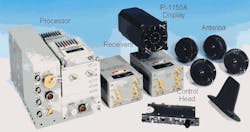Northrop Grumman to provide processors and detectors for radar warning receivers aboard aircraft and ships
PATUXENT RIVER NAS, Md. – U.S. Navy avionics experts are asking engineers at Northrop Grumman Corp. to provide components for an upgrade to the Navy's AN/APR-39 family of radar warning receivers, which will have new digital signal processing (DSP) capability.
Officials of the Naval Air Systems Command on Monday awarded a $31.3 million order to the Northrop Grumman Mission Systems segment in Rolling Meadows, Ill., for weapon replaceable assemblies and AN/APR-39D(V)2 support equipment hardware.
Components will include 31 processors, 124 antenna detectors, 96 radar receivers, 31 low band arrays, and 14 battery handle assemblies for the AN/APR-39D(V)2 radar warning receiver.
The AN/APR-39D(V)2 is the latest upgrade to the AN/APR-39 radar warning receiver that corrects deficiencies and enhances capability in the same weight and dimensions as the previous system. The upgrade calls for a new digital receiver for the AN/APR-39D(V)2.
The AN/APR-39 family of radar warning receivers is for a variety of Navy aircraft and ships. It detects radar threats to aircraft, such as radar ground sites and particularly radar-guided missiles, and provides 360-degree coverage around the aircraft. When the system detects radar threats, it alerts the aircraft crew to each threat with a graphic symbol on the cockpit display.
The APR-39 provides the pilot and air crew with information on threat types, bearing, and the severity of the threat. The system also gives the aircrew synthetic speech audio threat warnings.
The APR-39 also functions as an electronic warfare management system, and serves as the heart of Northrop Grumman's suite of integrated sensors and countermeasures that integrates and displays data from onboard sensors radio frequency and electro-optical sensors.
On this contract modification, Northrop Grumman will do the work in Rolling Meadows, Ill.; Woburn, Mass.; Lansdale, Pa.; Menlo Park, Calif.; Lewisburg, Tenn.; Verona, Wis.; Longmont, Colo.; Phoenix; New York; and Melbourne, Fla., and should be finished by October 2024.
For more information contact Northrop Grumman Mission Systems online at www.northropgrumman.com, or Naval Air Systems Command at www.navair.navy.mil.
About the Author
John Keller
Editor-in-Chief
John Keller is the Editor-in-Chief, Military & Aerospace Electronics Magazine--provides extensive coverage and analysis of enabling electronics and optoelectronic technologies in military, space and commercial aviation applications. John has been a member of the Military & Aerospace Electronics staff since 1989 and chief editor since 1995.
